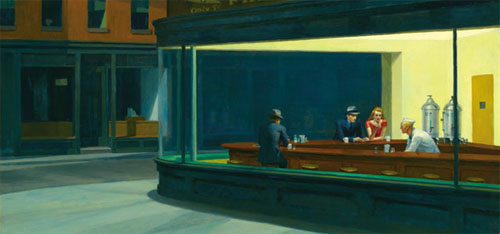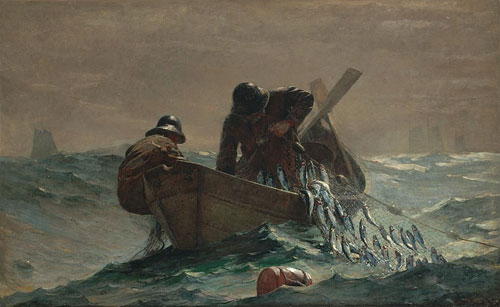Took a day off work today and went to see the Homer/Hopper Exhibitions at the Art Institute of Chicago. Kind of a sloppy day downtown — we’ve had a lot of snow and now a small warm-up is messing things up.
But that’s the way things go in the big city.
We timed things right this time: We got there when the museum opened, and during the first hour the big exhibitions (in this case, Homer Hopper) are open to members only, no tickets required. So we sailed in.
Hopper was great – the crowds were non-existent and the art was stunning. It was missing a couple of pieces I’ve seen over the years in magazines etc, but had others I’d never seen. (Actually, I’ve hung Hoppers when I worked at the Terra Museum of American Art. I just recalled that! One great picture of a house that was missing from this exhibit).
One of the highlights of the exhibit was, of course, one of the Art Institute’s prizes: Nighthawks.

Hopper is enigmatic to me: He built a summer home with grand views of the Atlantic, but instead painted the cars parked looking inland, for example. The people in his pictures often don’t work (for me), but when they do – as in Nighthawks – they pose more questions than they answer. I like this, but I could see others getting frustrated with him. OK, are they lovers or not? WTF is going on?
I enjoyed greatly.
I’ve always been a Hopper fan, and this was a chance to see more of his stuff, and to get to know a little more about the man (Example: He didn’t sell a picture until he was in his early 40s: What kept him going?).
To me, Hopper is a purist who pursued his own vision. While I see his work reflecting the works of others (Charles Sheeler, Edward Weston, some surrealists [to a degree], even Pete Turner ). I just don’t know enough to say who influenced who.
While all artists are influenced/polluted by other artists (yeah, pick your verb), Hopper still – in the end – just painted what he wanted to. Sure, the palette was influenced by X and the perspective by Y, but – in the end – it was all unmistakably Hopper.
Hard light, naked environments (forests or streets, they are immaculate and with structural joints/streets at right angles and so on) and completely masked personnel (what’s going on here that I’m missing???).
The Winslow Homer exhibit, on the other hand, had more items – and many great combinations of sketches and final work, always nice. And most were of a smaller scale (often more photographic in size – 24 inches max height or width), so you had to get closer.
Unfortunately – at this point – the crowds were getting thicker, and all the idiots with the audio tour headsets were just moving like sheep from one picture to the next, regardless of if I was trying to read the description or what have you.
The Homer exhibit was focused on his watercolors, and they are magnificent. I enjoyed Hopper a great deal more, but Homer has some good stuff, no question. He reminds me of Turner and Church, and – to some degree in some work – Monet.
That’s not shabby company.
Below is one of Homer’s masterpieces, The Herring Net. When a huge school of herring flocked to the area where Homer was summering, the New England fishing fleet swarmed the area. Homer went out in a boat to do the sketches that would result in this painting. Points for getting close to the action!

Worth seeing. Just do it during an off hour.
